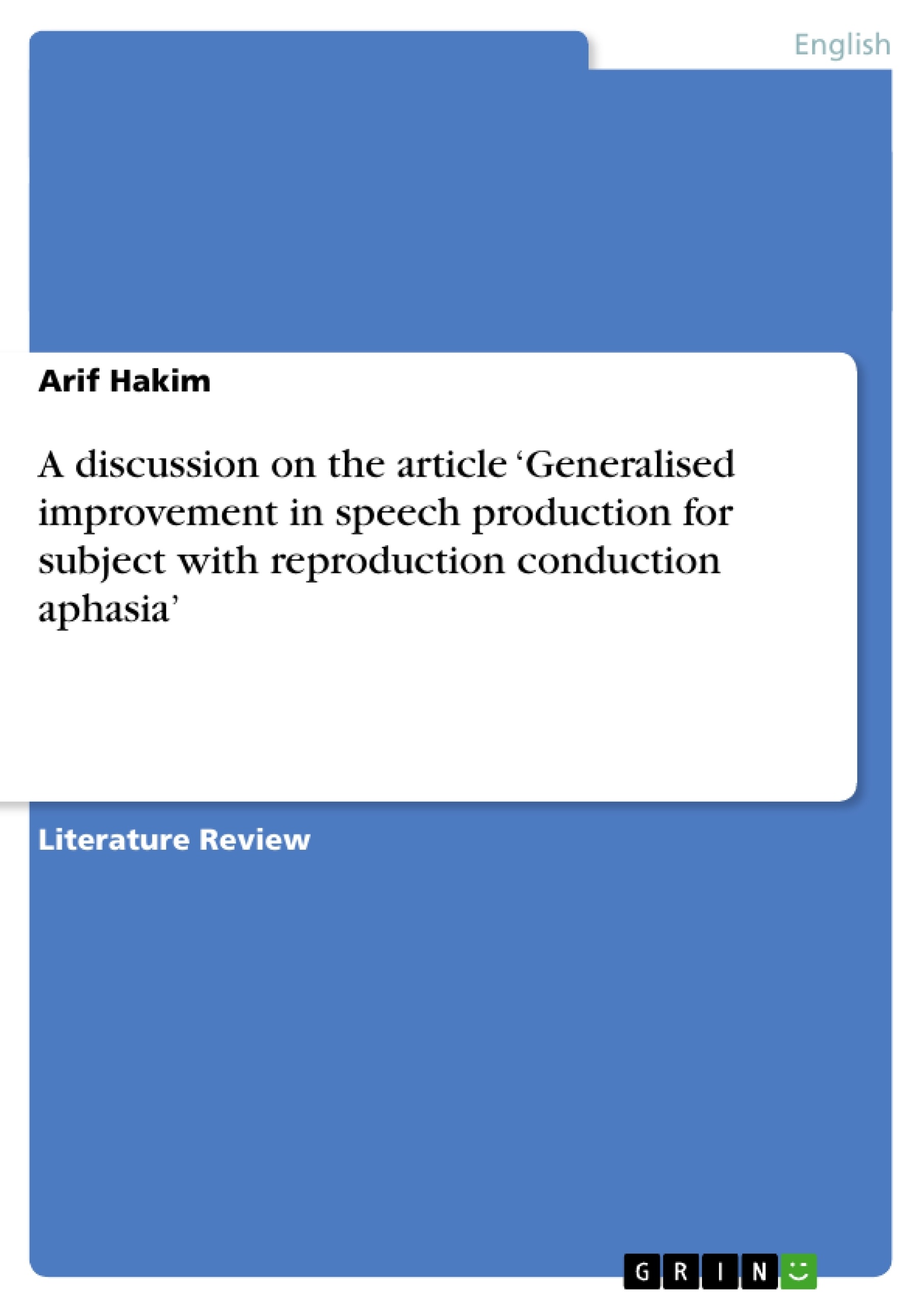Speech production, the prime language activity of human beings, involves a process
of cognitive endowment. It includes some internal mechanism of language production
that engages several chronological stages like auditory analysis system, phonological
input lexicon, phonological output lexicon, and output buffer. Here, impairments in
former two stages exhibit comprehension problems of speech production of human
beings, whereas impairments in later two stages denote production deficiency in this
regard (Basso, 2003: 127). In the article ‘Generalised improvement in speech
production for subject with reproduction conduction aphasia’ Sue Franklin, Frauke
Buerk, and David Howard depicted a case study of a patient MB who faced a problem
with speech production especially phonological encoding process at the post lexical
level that includes phonological output lexicon and output buffer. Thus, MB made
frequent phonological production errors in all modalities but reduced significantly
after some therapy sessions conducted by the authors of the article.
Inhaltsverzeichnis (Table of Contents)
- Introduction
- Previous literature
- Baseline test
- Pre-Assessments Tasks
- Summary of the pre-assessments tasks
- Tests of treatment
- Treatments
- Phase 1: Phoneme discrimination tasks
- Phase 2: This self-monitoring phase
- Phase 2a: In this ‘external monitoring' phase
- Phase 2b: This 'indirect monitoring' phase
- Phase 2c: In this ‘direct internal monitoring' or 'on-line judgement' phase
- Further Analysis
Zielsetzung und Themenschwerpunkte (Objectives and Key Themes)
This article examines a case study of a patient, MB, diagnosed with reproduction conduction aphasia. The authors, Sue Franklin, Frauke Buerk, and David Howard, conducted therapeutic interventions to improve MB's speech production abilities, particularly focusing on phonological encoding. The article analyzes the effectiveness of the implemented therapies and aims to provide insights into the nature of phonological deficits in this specific type of aphasia.- Phonological encoding in speech production
- Reproduction conduction aphasia and its characteristics
- The effectiveness of therapy interventions for phonological deficits
- Analysis of post-lexical and lexical deficits in speech production
- The impact of word length, frequency, and imageability on speech production
Zusammenfassung der Kapitel (Chapter Summaries)
The introduction provides an overview of speech production, highlighting the various stages involved and the implications of impairments in different stages. It introduces MB, the patient in the study, and describes her diagnosis of reproduction conduction aphasia, characterized by phonological production difficulties. The authors' motivation for conducting the study is explained, drawing upon existing research in cognitive neuropsychology. The 'Previous Literature' section reviews various models of speech production, including Levelt et al.'s model emphasizing functional separability of processing levels and Dell et al.'s model focusing on connections between lexical nodes and phonemes. The section also explores the concept of rapid decay of phonological representation proposed by Miller & Ellis, and Caramazza et al.'s observations on the dissociation between word and non-word production. Finally, the monitoring account of phonological errors by Sehlenk et al. is presented. The 'Baseline Test' section describes the initial assessment of MB's abilities, including the Nickels Naming Test and TROG. The 'Pre-Assessments Tasks' section details the pre-treatment assessments, including spoken word-to-picture matching, auditory matching span, and auditory rhyme judgements. These assessments helped to identify MB's specific challenges in auditory processing and phonological production. The 'Summary of the pre-assessments tasks' section summarizes the findings of the pre-assessments, concluding that MB exhibits a post-lexical, phonological output problem. The 'Tests of Treatment' section outlines the five phases of treatment, including the pre-tests, post-treatment evaluations, and a follow-up assessment. The 'Treatments' section describes the five phases of therapy, focusing on phoneme discrimination tasks and self-monitoring strategies. The 'Further Analysis' section examines the results of the treatments and provides an in-depth analysis of MB's phonological deficit.Schlüsselwörter (Keywords)
This article explores the complex area of speech production, specifically focusing on phonological encoding, reproduction conduction aphasia, and the effectiveness of therapeutic interventions. Key terms include phonological errors, lexical and post-lexical deficits, word frequency, imageability, syllable length, and treatment modalities. The study provides valuable insights into the nature of phonological deficits in this specific form of aphasia and highlights the importance of targeted therapy interventions for improving speech production abilities.- Quote paper
- Associate Professor Arif Hakim (Author), 2006, A discussion on the article ‘Generalised improvement in speech production for subject with reproduction conduction aphasia’, Munich, GRIN Verlag, https://www.grin.com/document/132491



